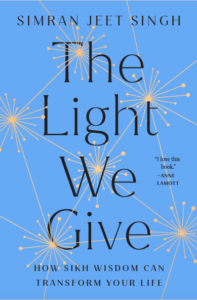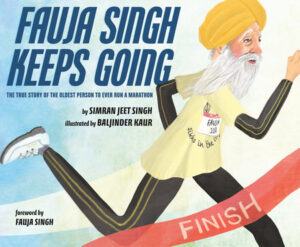Sharing Sikh Wisdom with the World: A Conversation with Simran Jeet Singh
Kali Handelman chats with Simran Jeet Singh about his forthcoming book and his work to educate people about the Sikh tradition

(Image source: simranjeetsingh.org)
Simran Jeet Singh might be the busiest person I know. And he definitely has more Twitter followers than anyone else I know.
Simran is an author, a scholar, an advocate for the Sikh community, a public speaker, a parent, a marathoner — the list goes on — and he’s also the newly appointed Executive Director of the Program on Religion and Society at the Aspen Institute. Revealer readers may also recognize him from his time as our Henry R. Luce Initiative on Religion in International Affairs post-doctoral fellow, or from his articles on the vulnerability of being a public figure and the meaning of service.
Simran and I began talking in graduate school, and I’ve been fortunate to remain in conversation with him since then. We’ve discussed the risks and rewards of writing about religion online and how he navigates being both a scholar and an activist. For this exchange, I wanted to talk about Simran’s debut book for adults, which comes out in 2022 (he already published a wonderful book for children in 2020). Simran has crafted a unique career, moving between activism and academia, and his forthcoming book is a huge moment in that journey.
Kali Handelman: Simran, you have spent the past few years writing books that introduce the Sikh tradition to a wide audience. First, you published Fauja Singh Keeps Going, a children’s book, which my colleagues at NYU had the pleasure of talking to you about already (here). Your book for adults, The Light We Give: The Power of Sikh Wisdom to Transform Your Life, comes out next year. What can you tell us about this new book? And what does it mean to write about Sikh wisdom and to aim the book at a wide audience (the book is being published by Penguin Random House!)?
 Simran Jeet Singh: Thanks so much for asking. I’m excited about this book for so many reasons, and being able to share Sikh teachings with the world is one of the foremost among them. Sikh wisdom has helped me find joy and peace in a world that can be really devastating. As I look around and see people struggling, I feel moved to share the tradition that has helped me find light within darkness.
Simran Jeet Singh: Thanks so much for asking. I’m excited about this book for so many reasons, and being able to share Sikh teachings with the world is one of the foremost among them. Sikh wisdom has helped me find joy and peace in a world that can be really devastating. As I look around and see people struggling, I feel moved to share the tradition that has helped me find light within darkness.
In that sense, the book is about sharing principles and insights from a tradition that I have come to cherish in ways that feel meaningful for people of all backgrounds, from those who grew up in the tradition and know it intimately to those who might be encountering it for the first time. That there aren’t many books like it in mainstream publishing has been both a challenge and an opportunity: a challenge because it’s meant that I can’t assume a reader who picks up the book will know much about Sikhi, if anything at all, but also an opportunity to help tell that story from the beginning, without any expectations or strings attached.
KH: Could you give us an example of what you mean when you talk about Sikh principles and traditions, and maybe about the process of identifying what wisdom you wanted to share and how you wanted to share it? Are there examples from the book that come to mind?
Absolutely. I try to show rather than tell. I didn’t want it to be a didactic read in which the reader is hammered over the head with instructions and information. I wanted it to be an artful and enjoyable book where the reader absorbs the ideas and understands what they look like in our lives. In a way, this approach draws from my teaching philosophy.
For instance, one important principle in Sikhi is serving others and fighting for justice. I’ve been thinking about that principle a lot lately in the context of today’s call-out culture, and I think readers of all backgrounds could benefit from what the Sikh tradition says about activism rooted in love. But rather than simply stating this in the book, I ask what it was about the message of Guru Nanak, the founder of Sikhi, that created longevity, so that 550+ years later his legacy lives on. Part of that, I think, is how he responded to ideas that he opposed. He was not afraid to critique, that’s for sure. Yet unlike what we see so often in modern activism, he didn’t stop there; Guru Nanak always offers solutions, both in terms of how we can imagine change and also how we can achieve it personally and institutionally. He doesn’t simply denounce casteism, or misogyny, but he creates mechanisms to undercut those oppressions, including practices like the shared meal of langar to the adoption of a shared last name to abolish the sense of social hierarchy. Guru Nanak’s approach has been instructive to my own work in the world, including in scholarship, where so often we problematize and deconstruct, and then move on without ever considering how our work might contribute to greater justice and equity. But what would it look like to create and build in the way that Guru Nanak envisioned and enacted — how could it change what our world could be and who we might become?
KH: That’s a really compelling example that makes me want to ask you about your path to writing this book. You’ve spoken before about the importance of representation, of telling and hearing stories that are different from normative, mainstream ones (that is, stories about people who are white, Christian, able bodied, heterosexual, cisgender). Was representation — telling a different story and helping people to think differently about, well, difference, a goal for you in writing this book?
SJS: Believe it or not, I have been dreaming of writing this book since childhood. Growing up in a country where 70% of Americans can’t identify a Sikh while looking at one, and where I was often on the receiving end of bigotry, it was always clear to me that our collective ignorance about one another contributes to our pain. What wasn’t clear to me was why Sikhi, as the world’s fifth largest religion, was left out of the conversation so often. Whether in our school textbooks or local interfaith programs, we didn’t even get to be an afterthought.
One of my goals in graduate school was to help make Sikhs more legible, and I attached a specific vision to it. One day, soon enough, I would write a book on Sikhi that appeared in the Religion section of a national bookstore. I didn’t know then that bookstores would soon be obsolete (too soon?). I also didn’t know then that I would have an opportunity to achieve this goal with my debut book. But to me, representation is absolutely a driver behind this book — not for its own sake, but because cultural and religious literacy is a key step in advancing pluralism and social cohesion.
KH: When we first spoke about doing this conversation, we talked about the idea of “values.” We were riffing on how there are at least two senses of “value” relevant to publishing your book. First, there’s the question of what the market — in this case, the publishing/literary market — values, as in, what people are expected to buy. That is the economic sense of the word. And then second, there’s the moral sense, the kind of values we hold — and this book is very much about those kind of values. But what I’m interested in asking you is where those two senses intersect. Could we say this book is important because it shows that there is room in the market for books and stories like yours and, at the same time, because you want to shift our moral sense of what is important and right — what’s valuable.
SJS: I love this question because it’s exactly the needle I’ve been trying to thread, both in my career and with this book. You know, one of the challenges I faced in getting this book off the ground was a chicken-egg problem. I couldn’t demonstrate this book would sell well because there were no comparable titles on Sikh wisdom with good sales; but there are no titles on Sikh wisdom with good sales because there’s no market demonstration that these books will sell well. To be transparent here, I spent more than a year working with my agent to finetune a proposal that we thought would help break that cycle and show potential publishers and editors that there was a strong value proposition here.
Part of that value proposition, as you rightly state in your question, is that values themselves have value, that people in our world today are looking for that kind of guidance. I found this incredibly difficult to land, not because there’s no space for it in the publishing world — the self-help market speaks for itself — but because I didn’t personally feel like I had a unique perspective that added value here. Part of my own discovery process was recognizing how I downplayed what I brought to the table, not just personally as a Sikh, but also as a scholar of the tradition. I guess what I’m trying to say is that I had to figure out how to package the values of Sikhi in ways that appeal to publishers and editors, many of whom are white and have never heard of Sikhi before. Some of the challenge comes in what I have internalized over the years, and some have to do with pushing my way into an industry that has not had space for people like me or stories like ours. I’m hopeful that this book will solve some of those problems and open up new channels and opportunities.
KH: Let’s talk about “public writing” about religion, that is, non-academic writing. Along with a children’s book and this new book, you also write for Time, Washington Post, CNN, and Religion News Service (I honestly do not know how/if you sleep, but that’s not where this question is going). What I want to ask is, where does the academic work — your training and scholarship in religious studies — fit into the work you are doing now? Has that scholarly experience been relevant and, if so, how?
SJS: Oh, absolutely. My scholarly training has not only been relevant to my public writing, it has been essential. One obvious element is what many in the writing community refer to as “bonafides.” The credentials of being an expert commentator open up doors and opportunities that would otherwise not be accessible.
 More than that, though, I’ve been served really well by some of the basic skills that scholars receive through our training, including the ability to research topics I don’t know much about, the ability to think through issues that communities are facing, and the ability to identify problems and challenges in the broader discourse. Of course, writing is probably the skill I lean on most heavily. It has taken some practice to learn how to speak to different audiences and write in different genres. There has been some unlearning too, including some particularities of academic writing. But overall, having a strong foundation in writing and the ability to think through what’s happening in the world has created endless opportunities — and I think that’s something anyone in religious studies could do if they are interested and willing to put the time toward it.
More than that, though, I’ve been served really well by some of the basic skills that scholars receive through our training, including the ability to research topics I don’t know much about, the ability to think through issues that communities are facing, and the ability to identify problems and challenges in the broader discourse. Of course, writing is probably the skill I lean on most heavily. It has taken some practice to learn how to speak to different audiences and write in different genres. There has been some unlearning too, including some particularities of academic writing. But overall, having a strong foundation in writing and the ability to think through what’s happening in the world has created endless opportunities — and I think that’s something anyone in religious studies could do if they are interested and willing to put the time toward it.
KH: You always have a ton going on — just casually dropping into conversations this or that amazingly cool new collaboration or publication — so, I have to ask, what are you working on now? What’s next that you’re especially excited about?
SJS: Oh gosh, lots to be excited about, some of which I can’t yet discuss because it’s still cooking. I’m excited about my new role with the Aspen Institute, because I think we’re developing something really special around cultivating pluralism and religious equity. I’m also excited (and nervous!) about a new short story I have coming out because it’s a genre I haven’t written in yet and that lends itself really well to dad-jokes.
I think what I’m most excited about and most focused on right now is sharing this book with the world and seeing what kind of reception it gets. I’m hoping to create lesson plans around it so that it’s easy and fun to teach, and I’m hopeful there will be opportunities to reach new audiences. In addition to sharing powerful wisdom, I hope this book will also help humanize people that they might have seen as foreign or unfamiliar. More than anything though, I’m hopeful this book gets me on Saturday Night Live and launches my new standup career — I can’t wait until my first Netflix special. I’d call it the Pun-jabi.
Kali Handelman is an academic editor based in London. She is also the Manager of Program Development and London Regional Director at the Brooklyn Institute for Social Research and a Contributing Editor at the Revealer.
Dr. Simran Jeet Singh is Executive Director of the Aspen Institute’s Inclusive America Project and a Soros Equality Fellow with the Open Society Foundations. He is the author of The Light We Give: The Power of Sikh Wisdom to Transform Your Life (Penguin/Riverhead 2022), which is available for pre-order now.